Hanuman: The Revered Monkey God in Hindu Mythology
The revered monkey god Hanuman is one of the most iconic in Hindu mythology. He embodies unparalleled strength, unwavering devotion, and boundless...
Maya M. Tola 19 September 2024
When people mention the Terracotta Army, the first thing that comes to mind is the phrase “the eighth wonder of the world”. It is a symbol of China’s thousands of years of culture. The First Emperor’s Terracotta Army and burial complex was a spectacular find. They were part of a grand scheme to recreate the entire world of his court underground. But why was Qin Shi Huang, the First Emperor, so obsessed with immortality and defense – even in death? What effect did the creation of the First Emperor’s Terracotta Army have on burial customs after his dynasty?
The Terracotta Army is one of the most incredible recent discoveries from ancient Chinese history. It is a collection of terracotta sculptures depicting the armies of Qin Shi Huang, the first emperor of China. At the time, emperors started building their tombs as soon as they took the throne. By studying the Terracotta Army, we can learn so much about Chinese society from 2200 years ago.
For centuries, people living in villages near Xi’an, Shaanxi province, China, heard stories of ghosts and spirits living beneath the earth. Many years ago, this area was the home of the Chinese emperor Qin Shi Huang.
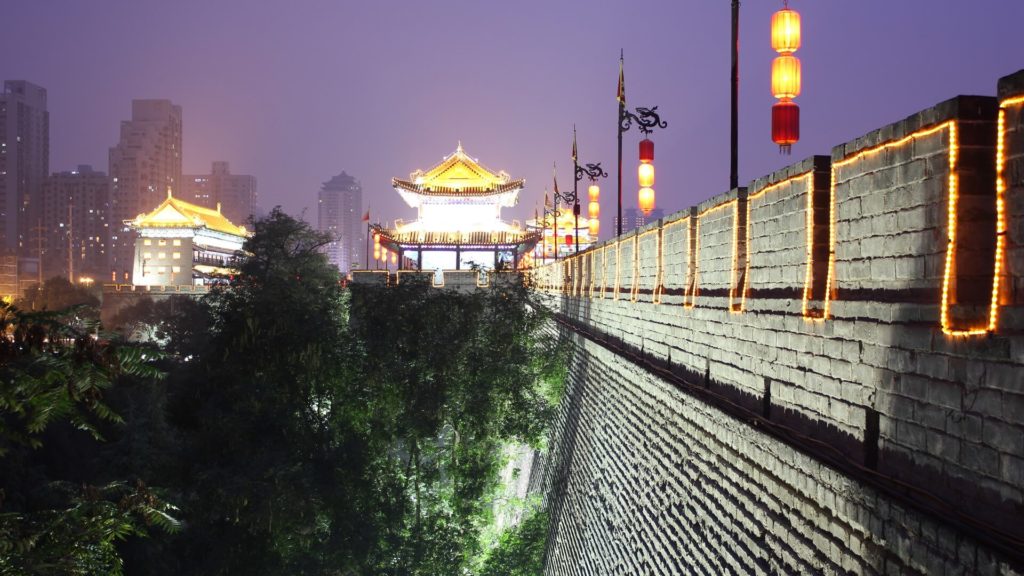
In the early 20th century, a farmer was digging in a field near Qin Shi Huang’s mausoleum. The earth suddenly crumbled beneath his feet, revealing an underground cave. Standing there was the perfectly formed, life-sized figure of a warrior made of baked clay called terracotta. But who put this amazing figure here? And why?
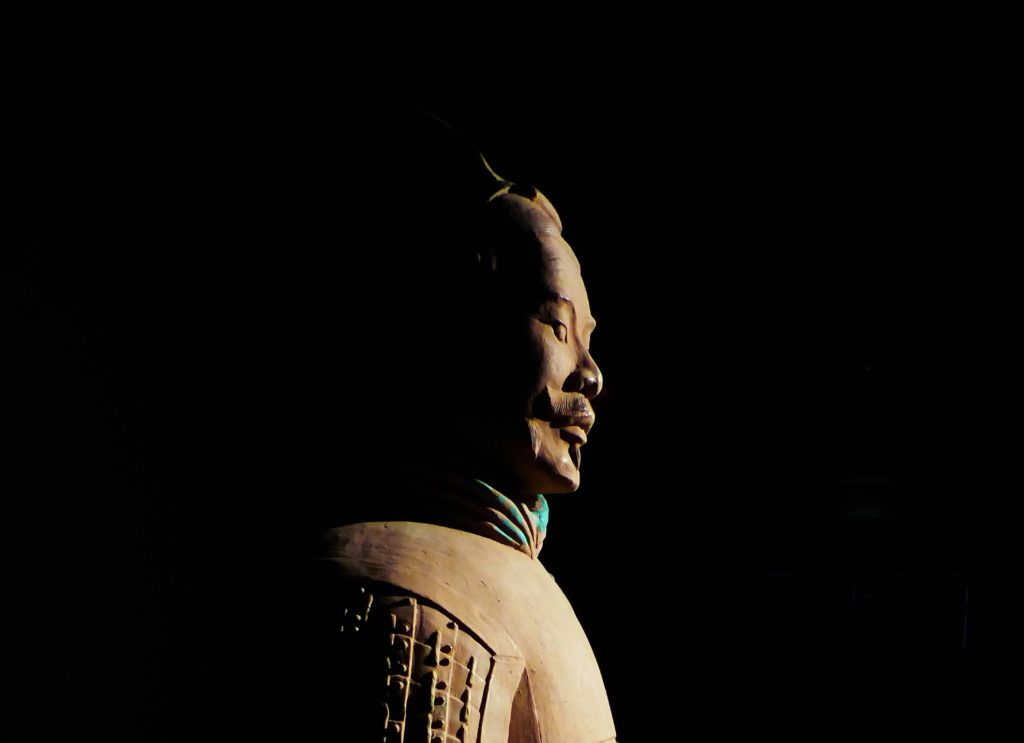
Years passed, and life in rural China was difficult. Growing food for people always seemed more important than broken pieces of pottery in the plowed ground. However, in 1974, a group of Chinese farmers, digging a water well, rediscovered a few figures of this huge Terracotta Army. Soon, top Chinese archeologists came to survey the site. The findings were even more interesting because they were so close to Qin Shi Huang’s tomb.
The first emperor of unified China, Qin Shi Huang, was born Prince Zheng of Qin in 259 BCE into a world of war. From 480 to 221 BCE, Qin and six other kingdoms, collectively known as the Warring States, were fighting for domination and control. These powerful kingdoms were called Qin, Han, Wei, Zhao, Chu, Qi, and Yan. They formed much of what later became modern China.
Prince Zheng became king when he was 13 years old. As he grew older, he gained more experience and became a decisive warrior king. He created one of the world’s most powerful armies. His forces went on to defeat the other Warring States. In 221 BCE, Zheng became known as Qin Shi Huang, the first emperor of Qin.
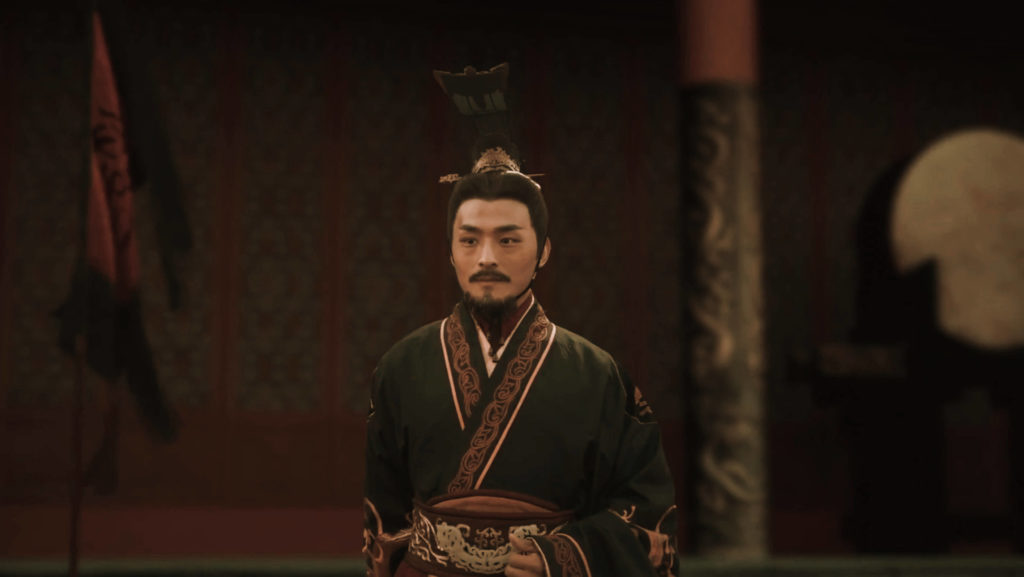
During his reign, Qin Shi Huang used slave labor excessively to build palaces, tombs, and the Great Wall to satisfy his ego. In spite of his dictatorship, Emperor Qin had a critical influence on Chinese history. After unifying China, he standardized weights and measures, and introduced a uniform writing script, thus enabling people with vastly different dialects to communicate. He also enacted a civil administration system that lasted for centuries. To display the emperor’s long-lasting influence on the Chinese system, a lot of films and documentaries have featured Qin Shi Huang’s life. One series worth watching is China’s Dragon Emperor, which excellently shows the motives behind Emperor Qin Shi Huang’s actions.
He built the mausoleum, probably hoping that his spirit would continue to live in the afterlife. Work on the mausoleum began in 246 BCE, soon after Emperor Qin ascended the throne, and the project eventually involved 700,000 workers.
A spirit city is a tomb complex that resembles a city. Spirit cities were based on the belief that after death, the spirit lives on in much the same way the person did while alive. The mound over the emperor’s burial chamber, the “spirit city”, lies in the southern part of a much bigger rectangle. Originally, high walls and a water-filled moat surrounded the whole area.
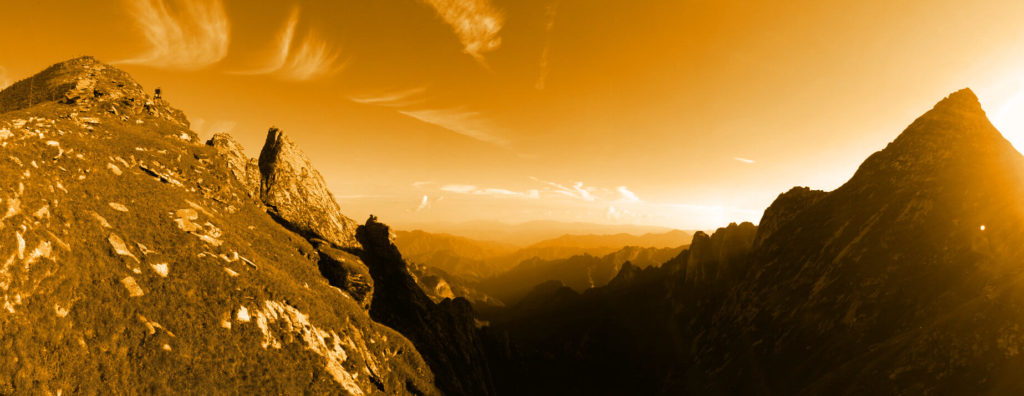
Some archeologists call this huge area “a city of spirits”, although no living person has ever called it home. Even after 2000 years, the mound still stands 43 m high. Huge inner and outer earth walls surround the burial area. The archeological digging also reveals an eastern wall or foundation of a building. The necropolis complex of Qin Shi Huang is a microcosm of the Emperor’s empire and palace. The Terracotta Army is located in the vicinity of the Mausoleum of the First Qin Emperor.
Yuan Zhongyi, one of the first archeologists to visit the Terracotta Army, noted that many of the archeologists had never seen such big pottery figures or such a large pit. He could not believe it. After surveying the test area and boring many holes, he discovered that the Terracotta Army indeed was a real find.
The archeologists have found four main pits containing the Terracotta Army. These pits have different shapes, sizes, and contain various pieces of the army. Pit 1 houses the army’s main battle formation of 6000 figures. Each warrior stands 175 cm tall. This pit has eleven corridors, most more than 3 m wide and paved with small bricks, and has a wooden ceiling. There are also 8 wooden chariots, 32 life-sized terracotta horses, and more than 1000 warriors. This design was also used for the tombs of the nobles and would have resembled palace hallways when built.
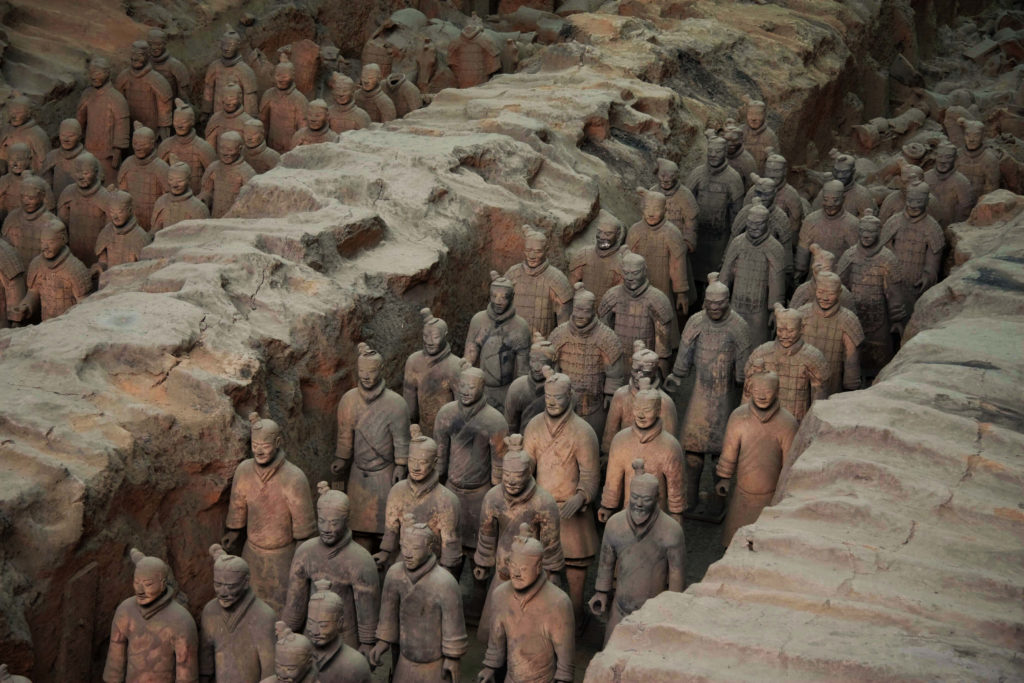
About 200 central units of infantry face east. These warriors wear armor. They once carried spears, swords, and other long-shafted weapons. A rear unit of about 100 soldiers faces west. Additionally, rows of archers on the outside, holding bows and arrows, face north and south. They are ready to protect the unit from attack from these directions. There were more than 10,000 bronze weapons.
Pit 2 is L-shaped and covers about 6000 sq m. It holds pieces of jade, gold, bone, iron, bronze, cavalry, and war chariots. Along with the infantry and chariots are units of 160 cavalrymen. These expert horsemen could ride and shoot a crossbow at the same time. Each soldier stands in front of his animal, one hand clutching the horse’s rein and the other clenched around a crossbow.
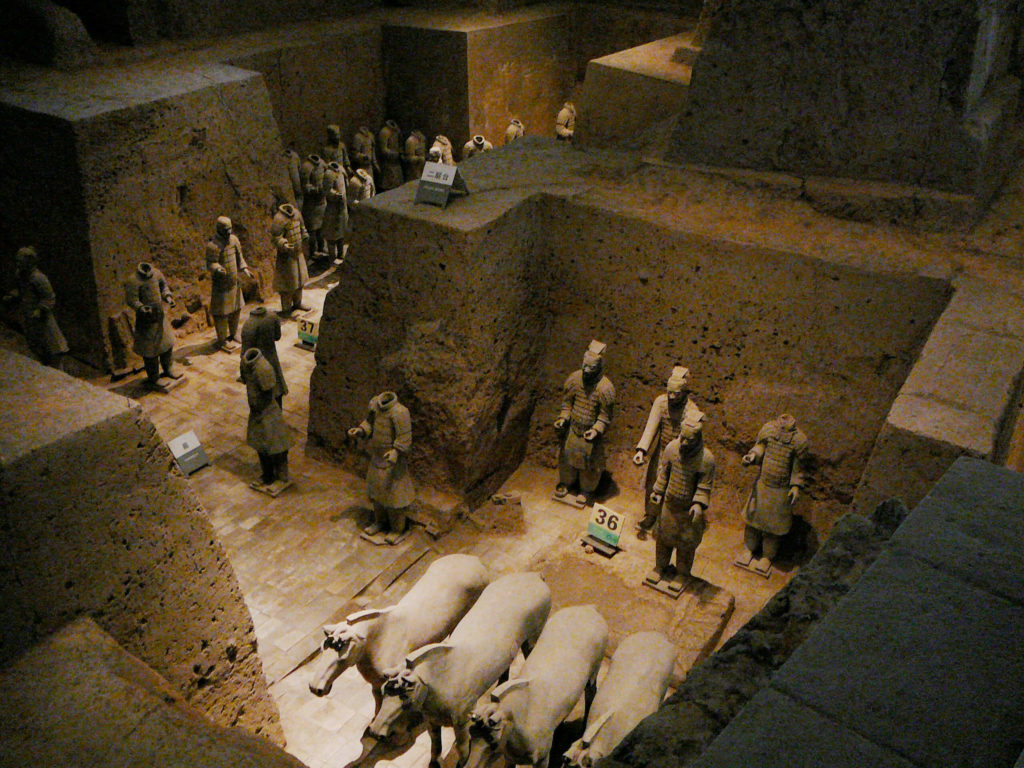
Pit 3 is roughly shaped like an irregular letter “U”. It is not nearly as large as other pits. Nevertheless, it has a few bronze arrowheads, one war chariot, and 60 soldiers. The main chamber of this pit may represent the command post for a high-ranking person. Perhaps it was a place for the spirits of the emperor’s best soldiers and horses to stay. Nearly all of these high-ranking officers are missing their heads. While other pits show evidence of raiders in ancient times setting the pits on fire, the inside of this chamber does not appear to have been burned.
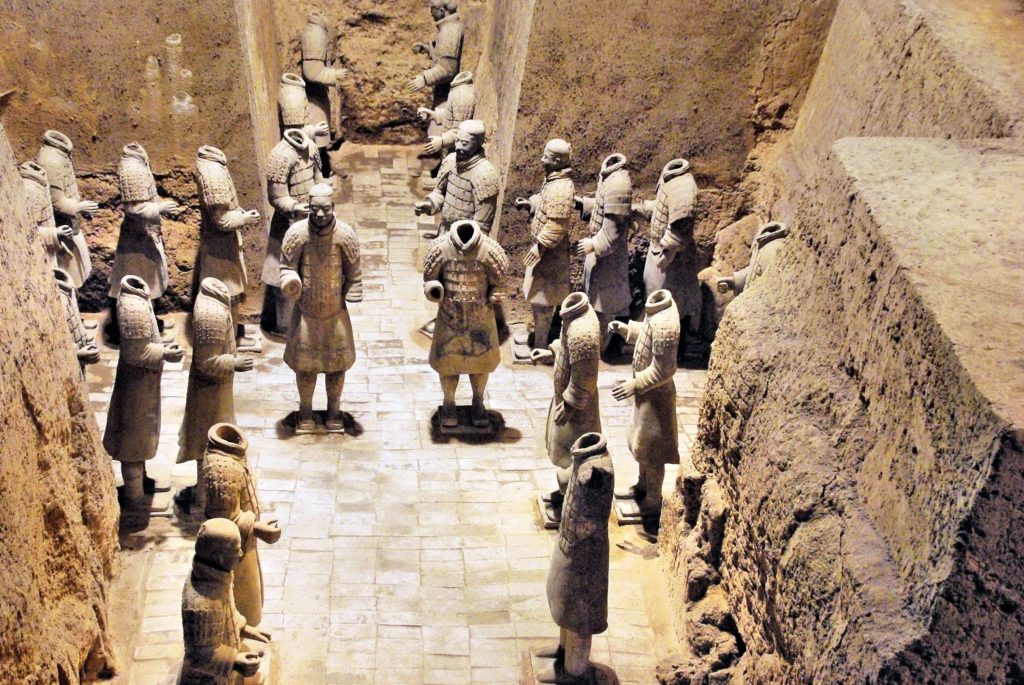
All in all, the number of warriors and horses in the pits is amazing. No one has ever found such a huge number of historical relics in one place. The three pits containing the Terracotta Army held more than 8000 soldiers, 130 chariots with 520 horses, and 150 cavalry horses. Surprisingly, Pit 4 was empty. The tomb complex was still unfinished when Qin Shi Huang died suddenly in 210 BCE. The craftsmen may have left the building in this way because its contents were meant to be spiritual, not physical.
The Museum of Terracotta Warriors was opened in Lintong County in October 1979. It allowed visitors to view the excavation close up from raised wooden walkways around the pit. Since then, Qin Shi Huang’s tomb complex and its museum have become known as the Eighth Wonder of the World. In 1987, UNESCO listed the tomb as a World Heritage Site.
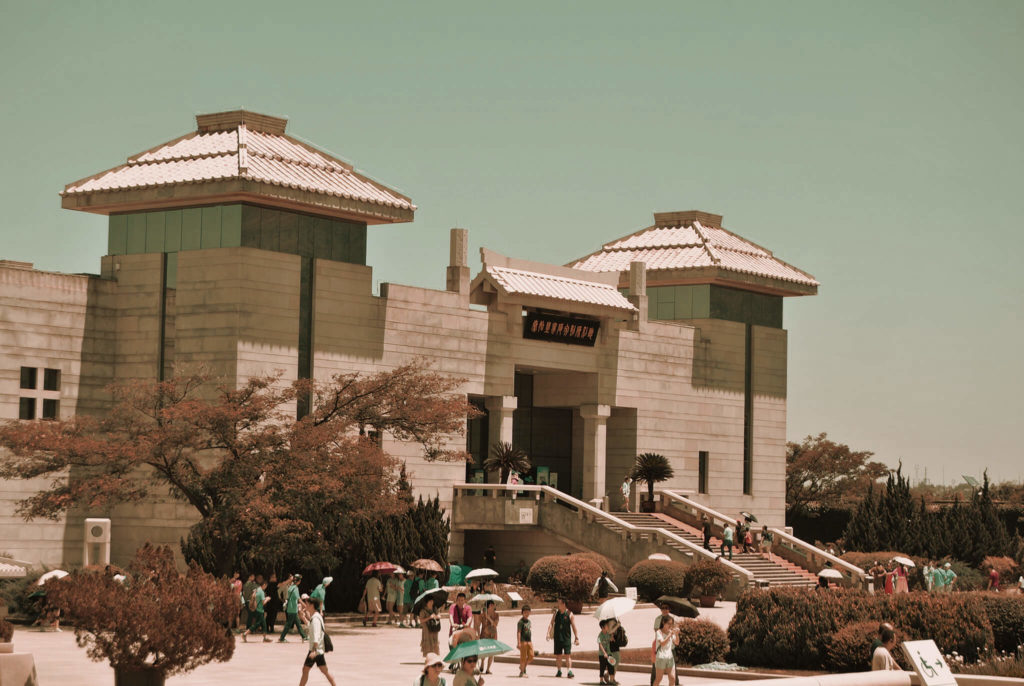
Probably nobody, not even the first emperor of China, Qin Shi Huang, ever saw the Terracotta Army in its entirety. The craftsmen originally placed most of the terracotta warriors facing east. Does this have something to do with the rising sun? The first emperor had chosen to build his capital city, Xianyang, in one of China’s most protected places. High mountains rise to the west. The Wei River flows to the south, the Great Wall protects the city against invasion from the north. But the capital was open to the east. Perhaps the emperor placed his army facing this way because he believed an attack would come from the east. He wanted to be ready for an invasion, even after his death.
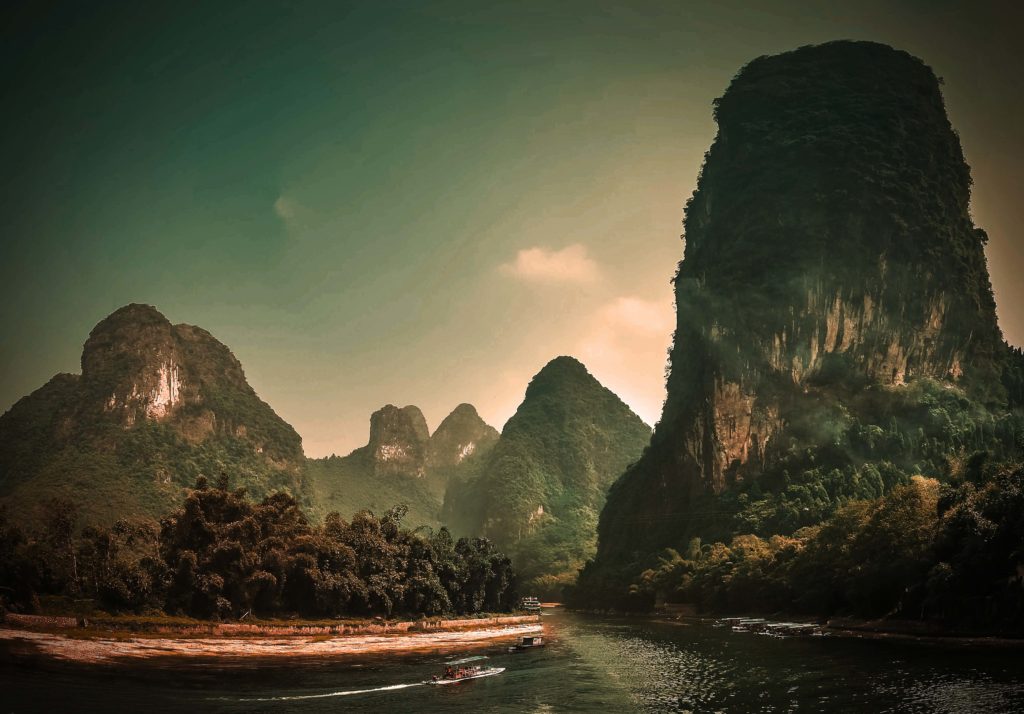
Buried in pits near the emperor’s tomb after his death in 210 BCE, the terracotta soldiers stand in line. Their legs, arms, bodies, and heads may have been made in molds. However, before they were fired in kilns, each figure was carefully sculpted by hand. Heads, arms, legs, and torsos were created separately and then assembled by combining the pieces. Then, the workers placed the terracotta figures in the pits according to rank and duty.
The warriors’ legs were probably made in much the same way that terracotta drainage pipes were manufactured at the time. In this case, the process looks like assembly line production, with specific parts manufactured and assembled after being fired, as opposed to crafting one solid piece and subsequently firing it.
During production, craftsmen paid special attention to the head and carefully designed each soldier’s hair, mustache, and other facial features. The colored lacquer finish and individual facial features would have given the figures a realistic feel, with eyebrows and facial hair in black and the faces done in pink. The workers probably used flat wooden paddles, sharp sticks, brushes, and metal tools for this work. They also added details to the warriors’ clothing and armor before baking the clay.
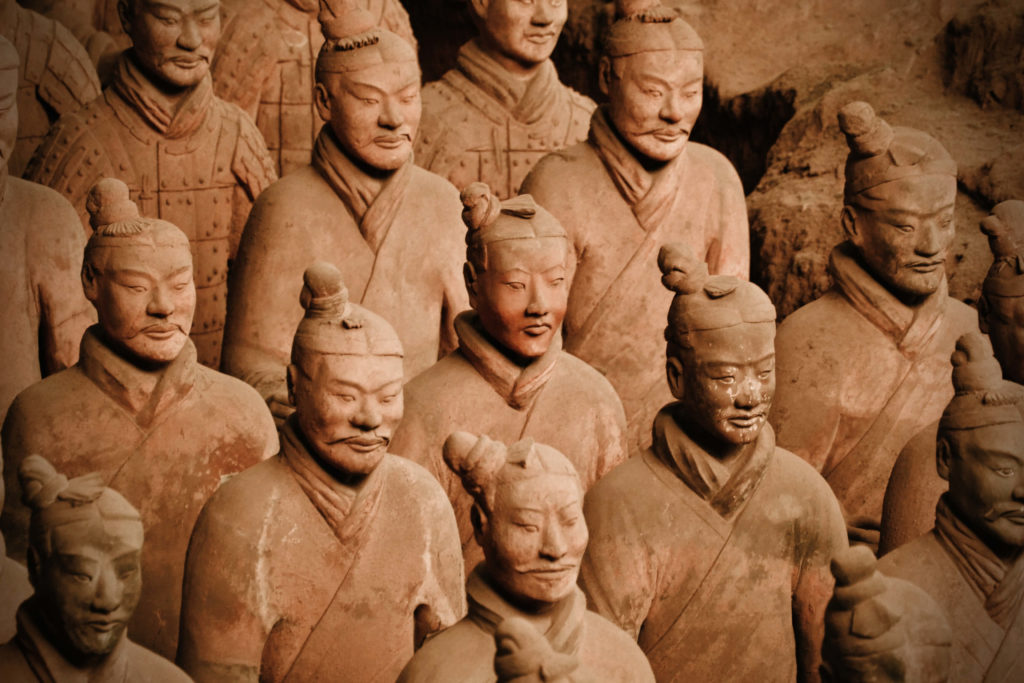
While every head and body looks different, the basic parts of most soldiers are similar. Why would the sculptors have gone to so much trouble to model unique warriors’ faces, only to bury them out of sight? The people who made these figures were laborers, prisoners, or slaves, not professional artists. Though a few skilled sculptors probably oversaw the project. Still, thousands of unhappy workers managed to construct one of the most beautiful works of art.
Since the army stands in a tomb, it seems to be ceremonial, not practical. However, terracotta warriors carry the best weapons of their day. Their hands were formed to hold actual weapons. These terracotta warriors were meant to be an actual army, ready to fight. Soldiers in the front unit wear no armor or helmets but they once carried crossbows and longbows. Longbows were wooden bows about 1.5 to 1.8 m long. A crossbow is a weapon made of a bow placed perpendicular across a wooden frame. The frame holds an arrow against the bow’s string. When a shooter pulls back the string and aims the crossbow like a rifle, a trigger releases the string, which shoots the arrow with great force.
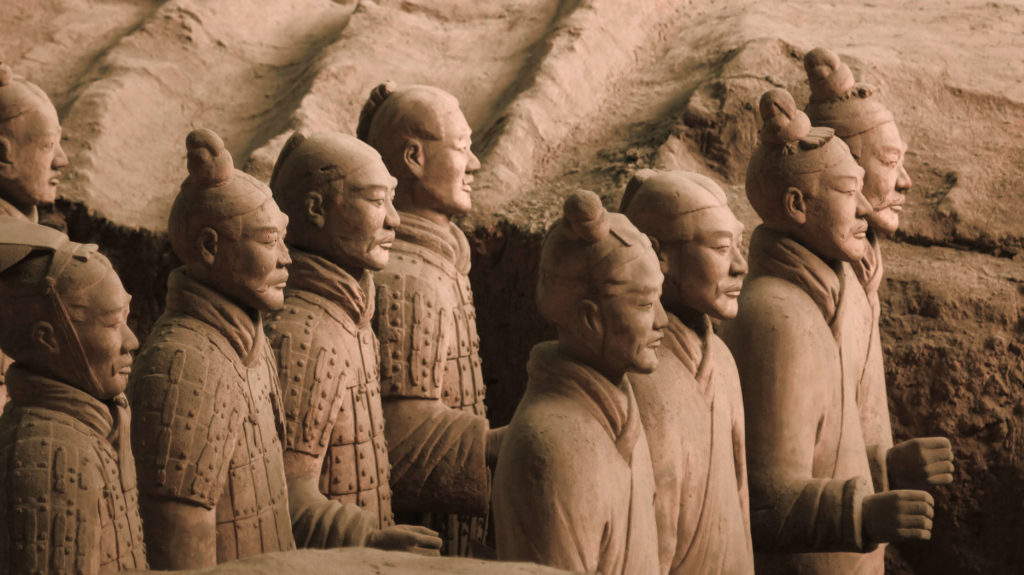
The soldiers have traces of red, brown, blue, purple, yellow, and green pigments on their clothing, shoes, and headgear. After the excavation of the Terracotta Army, the painted surface began to flake and fade.
The Terracotta Army is part of a much larger necropolis which is a microcosm of the emperor’s imperial palace. It covers a large area around the tomb mound of the first emperor. It could take fifty to one hundred years to uncover the whole area of the burial site. In their latest round of excavation, archeologists unearthed about 200 more terracotta warriors and a large number of weapons from Pit 1. As the teams continued to explore each new section of the tomb, they came across more startling objects.
While the figures are commonly referred to as warriors or an army, not all of them were soldiers. Some are stable hands, tradesmen, and other civilians. Workers even found the remains of rare birds and exotic animals in coffins containing dishes of food. Terracotta statues of the animals’ keepers are located nearby.
An estimated three hundred to four hundred additional pits may hold other animals and attendants. All of these figures are part of a huge city for the dead emperor’s pleasure. The archeologists even discovered acrobats, lifting, spinning, dancing, jumping, and making other movements. They also unearthed more than twelve life-sized bronze cranes. Represented in many Chinese traditional paintings, these birds have great spiritual meaning. They symbolize long life and immortality.
Close to the pits with horses and grooms is a row of seventeen pits filled with human bones. Some of these graves may also hold pieces of silk, as well as jade, gold, and silver objects. These items show that these real people were extremely important and wealthy during their lifetimes. They may have been the emperor’s children, killed in the rebellion that followed his death. Some scholars believe they may have even asked to die so that they could go with the emperor on his spiritual journey.
There is a mass grave about 1.6 km from the emperor’s tomb. These people lie outside the spirit city. Clay tablets buried with the skeletons identify them as forced laborers sentenced to death for crimes. This discovery reveals the contrast between these workers’ hard lives and the luxurious lives of the people they served.
Art and politics have been closely connected, and Qin Shi Huang’s terracotta warriors are not the only ones discovered in China. In 2003, south of Beijing, workers found a tomb holding thousands of horses, chariots, and terracotta soldiers. This tomb dates back to the Han dynasty (202 BCE–220 CE) that ruled China after the Qin dynasty. The practice of burying kings and nobles with symbolic armies must have been common in ancient China.
The chariots are some of the rarest discoveries at the Qin tomb site. No one has found anything like them in such numbers before. It feels like we can almost hear the sounds of the battlefield. Several horse-pulled chariots are part of the main battle unit. Each one once carried an armored driver and one or two warriors. These men also held spears or other weapons. The group of soldiers around each chariot probably cooperated with the chariot and its riders during battle.
Grooms specially bred and trained horses for battle. The horses of the Terracotta Army have eager eyes, tense muscles, flared nostrils, and wide neighing mouths. Everything about the army shows organization and strength. For an ancient army marching forward, appearing unstoppable was sometimes half the battle. Just the sight of Qin’s vast army moving toward the battlefield was often enough to send enemies fleeing in terror. The Qin army was more than ready to strike with incredible force.
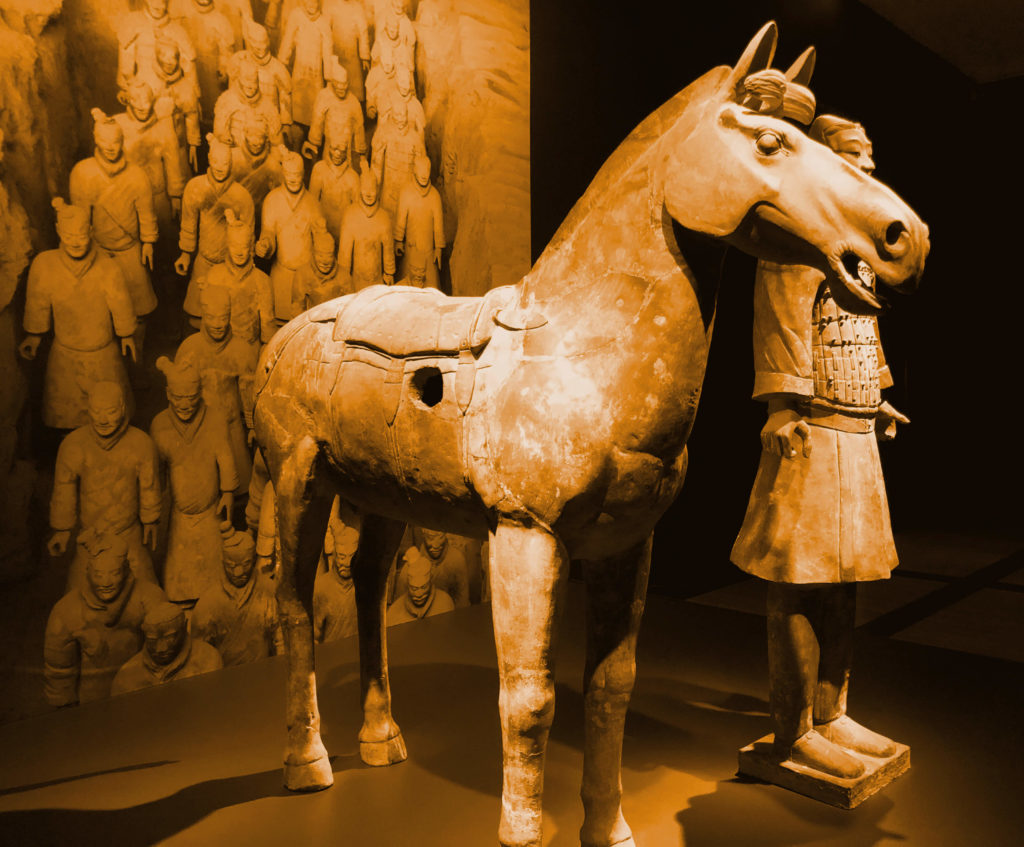
Four bronze white-painted horses once pulled each two-wheeled chariot. The hardware and fittings on the wagons and horses are mainly silver and gold. Delicately painted patterns decorate the precious metal. Each chariot also has a bronze driver. Wide bronze umbrellas protect the drivers from sun and rain. Based on the drivers’ clothing and hairstyles, these men held very high ranks in the army. They hold swords, ready to guard each side of the chariots. The bronze chariots were probably the vehicle for the journey of the emperor’s soul.

The larger chariot weighs more than 1179 kilograms. How did ancient metalworkers make the paper-thin bronze umbrellas protecting the drivers? These metal canopies are less than 0.2 cm thick. How did they make the intricate tassel decorations on each horse? The tassels are even thinner than the canopy. These metal creations are incredibly precise. Still, artists made them without any modern tools or technology.
According to ancient legends, wild and fearless Qin soldiers charged into battle without armor or helmets. Not carrying extra weight made Qin warriors faster and more agile than armored soldiers. They were a powerful and deadly fighting force. But most of the infantry, archers, and chariot drivers had armor. The archeologists have identified seven different types of armor. Most of the soldiers wear leather armor.
The workers have found three unusual weapons at the Qin site. They are the pi, dao, and shu. The pi is a sickle-shaped, 0.3-meter spearhead on the end of a 3-meter-long pole. The dao is a curved sword shaped like a crescent moon. The shu is a narrow, heavy piece of metal, 15 cm long and 2.5 cm across, shaped like a cylinder with a pointed top. It was attached to the top of a long pole. Warriors riding in fast-moving chariots swung shu-like clubs. In Qin times, warriors used them mainly for defensive purposes, not for attack. Warriors would have used such weapons to help protect an important person.

Some musical instruments also appeared in the pits among the warriors and chariots. In ancient times, soldiers used these instruments to guide the army. The sounds of drums told soldiers how and where to move in battle. For example, a single, regular drumbeat signified a steady movement forward. A faster beat or drum roll meant an attack. The sound of a bell ordered warriors to stop. A repeated ringing signaled a retreat. Directed by these signals, the Qin army operated like a giant machine, each part acting in perfect harmony with the others.
Archeologists call tomb figures and other buried items mingqi, or “spirit articles”. People placed these items in ancient tombs to recreate a dead person’s earthly life. Putting rare and valuable items in a tomb also showed a ruler’s power and status.
Soon after finding the first horse, the archeologists also discovered bronze swords, glistening and shining in the sunlight. The wooden parts of the weapons had rotted away long before, but the metal was still as sharp and shiny as it was when these weapons were first made. Some twisted metal pieces were triggers from crossbows. This Terracotta Army must have carried these weapons. What was more amazing was that these weapons did not have any rust on them.

Scientists found that ancient workers had treated the swords’ blades with a coating of salt and chromium. This unusual treatment may have protected the swords from rust. However, research in 2019 showed that the chromium was merely contamination from nearby lacquer, not a means of protecting the weapons. The slightly alkaline pH and small particle size of the burial soil most likely preserved the weapons.
The ruins of elaborate buildings and temples lie all around the tomb area. In ancient times, living people brought food offerings and other gifts to these buildings. Bronze and jade bowls and pots are scattered around the tomb complex. Visitors to the tomb once used these containers to prepare feasts for the dead emperor and his companions.
Earlier, people believed that models became real after the dead person entered the spirit world. In the afterlife, the image of a thing was as good as the real thing. That must be why Emperor Qin’s workers built and buried this huge army. It could follow the emperor’s spirit and protect him in the next world.

In ancient China, when wealthy and important people died, their families and servants were sometimes buried alive along with them. However, the tomb shows that this custom had changed by the time the emperor died. The emperor could easily have ordered the burial of his entire living army. So why didn’t he? He probably needed his warriors alive more than he needed them dead. He hoped they would ensure that the Qin dynasty continued.
What lies beneath Qin Shi Huang’s high burial mound? Is the emperor’s tomb as rich with jewels and gold as legends say? The only way to know for sure is to dig it up. However, doing so could destroy the very things the world has been waiting to see for more than 2000 years.

After more than 40 years, experts are just beginning to understand the full meaning of Qin Shi Huang’s tomb. With each passing year, it becomes clearer that all parts of the complex are connected like the pieces of a puzzle. Each discovery adds to the picture. The pieces show that the vast spirit city was a grand plan by Qin Shi Huang. The emperor and his advisers seem to have designed the complex so that he could enjoy the same luxuries after his death as he had in life.
Meanwhile, fascination with Qin Shi Huang and his Terracotta Army is growing. Whether the emperor was good or bad seems to matter less than his exciting story. History shows that Qin Shi Huang spent much of his life searching for the secret to eternal life. Apparently, he did not find it. Modern investigation shows that his tomb is, indeed, occupied. But the discovery of the First Emperor’s amazing Terracotta Army has made him famous around the world. That fame, in itself, is a kind of immortality.
The First Emperor’s Army. Posted by National Geographic via YouTube, Oct 16, 2016.
DailyArt Magazine needs your support. Every contribution, however big or small, is very valuable for our future. Thanks to it, we will be able to sustain and grow the Magazine. Thank you for your help!